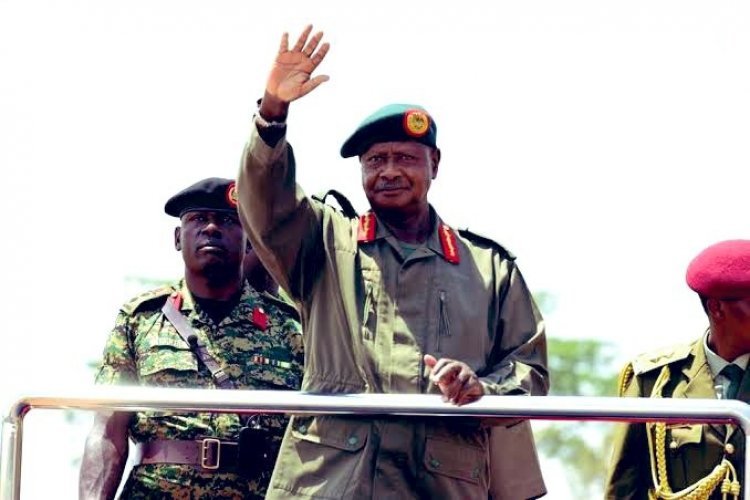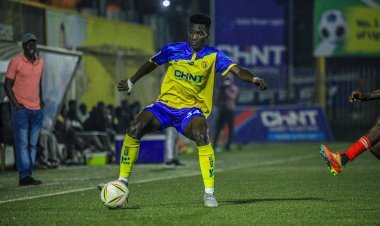FULL SPEECH: Museveni details how NRA captured power, Achievements of NRM at 42nd Terehe Sita Celebrations

Congratulations all Ugandans on the occasion of the 42nd Anniversary of Tarehe Sita. To inform the Bazukulu, the 6th of February, 1981, at 0800 hours (Saa mbiri z’asubuhi), is when the 43 of us, but with 27 rifles, attacked the huge garrison of the Kabaamba Military Training School with the aim of regaining some of the 9,000 rifles, Fronasa had handed to the joint force created after the defeat of the Idi Amin regime. This united force had been given the designation of the UNLA.
Although the attack itself, by God’s superior intervention, did not succeed when a Tanzanian Corporal, following Tumwiine’s pistol fire at the 2 Quarter-guard, rushed into the underground Armory and used an LMG to defend it against us, we collected about 40 rifles from the houses around, captured 8 lorries, were joined by some of our fighters such as Kyakabaale Anthony (RPG), successfully drove our fleet of vehicles through Kasaambya, Nabingora, Kyegyegwa, Kyenjojo, Kagadi, Isuunga, Karuguuza, Nkooko, Ntwetwe, Masode and by 0200hours of the 7th of February, drove through Kiboga town and camped at Budiimbo ─ in Matovu’s farm.
With that partial success, the Revolutionary Forces in Uganda had, after due warnings to the other groups, established an alternative power centre in Uganda. I say that the failure to capture the 1,000 rifles stored at Kabaamba was God’s intervention because, at that time, even if we had captured those guns, the UPC Government could have recaptured them from us because we had not yet gathered the thousands of our soldiers that the UPC had deliberately scattered all over Uganda.
Saleh was in Karamoja, Ivan in Pakwach, Mugume Joram in Moroto, Mugume Chagaa was in Jinja, Pecos Kutesa in Nakasongola, etc., etc.; so were the militants, scattered all over Uganda. It was, therefore, God’s intervention that we were able to launch the challenge to the UPC but not to be 3 burdened with the 1,000 rifles that had no people to immediately carry them. Indeed, on the 9th of February, the Government forces surprised our temporary camp at Kagobe, Kagulire’s home and recaptured some equipment, including my brief-case.
In my brief-case, there was a document, on which our new structure of the Resistance Army had been written. On the 7th of February, at Budiimbo, after looking for food and eating, I assembled the fighters and organized them as follows:
Section I - Sam Magara; Section II - Eli Tumwiine; Section III - Hannington Mugabi; Section IV - Jack Mucunguzi; and a few individuals, initially under Kabuura, constituted the Bodyguard of the Chairman of the High Command ─ that is yours and truly, Yoweri Museveni. Each of the sections had 12 rifles.
By the end of the 6th of February, 1981, we, therefore, had about 60 rifles compared to the 27 rifles we had started with.
We had also picked a very good RPG-7B from Isuunga Police Station, near Kakumiro. When the UNLA showed Obote and Paul Muwanga the parade state of the PRA, they just laughed with derision. They had forgotten the biology which informs us that a healthy zygote, may end up as a 4 giant human being. However, the zygote must be a healthy one and the PRA was such a healthy one.
By the 6th of February, 1986, eleven days after the successful storming of Kampala, the 4 sections of the PRA of the 7th of February, 1981, had grown as follows: 1st battalion - Pecos Kutesa and Fred Mugisha; 3rd battalion - Patrick Lumumba; 5th battalion - Steven Kashaka and Ahmed Kashillingyi; 7th battalion - Matayo Kyaligoonza and Stanley Muhangyi; 9th battalion - Julius Kihaanda; 11th battalion - Chefe Ali; 13th battalion - Ivan Koreta 15th battalion - Samson Mande; 17th battalion - Adam Wasswa; 19th battalion - Peter Kerim; 21st battalion - Benon Tumukuunde; Special Force - Jet Mwebaze; High Command Force - Akaanga Byaruhaanga. Each of these battalions had 1,500 rifles, except the 19th battalion which had 1,900 rifles.
The Mobile Brigade, under Salim Saleh, was comprised of the: 1st , 3rd, 5th, 7th, 9th, 13th and 15th. The 11th and the 19th 5 had been detached to the Western Axis under Tinyefuuza and the 21st, under Benon Tumukuunde, was kept in Reserve at Kasese to keep an eye on Mobutu.
This was now a force of about 20,000 rifles plus numerous support arms: mortars, recoilless cannons, 14.5mm, 37mm, a few strelas, etc. Eli Tumwiine was the Army Commander and Fred Rwigyema was the Deputy Army Commander, Why such growth in such a short time? It was on account of the following reasons:
1) People being desperately fed up with the brutality and non-accountability of the old armies ─ UA, UNLA; (2) UPC blocking the democratic process of genuine and constructive debate that we warned them about many times but never paid heed to our warnings: (3) The collapse of the economy ─ no consumer goods, no wealth creation, magendo, kibaanda, kusamula; (4) The correct ideology of the NRM comprised of the four principles of: (i) Patriotism; 6 (ii) Pan-Africanism; (iii) Social-economic transformation; and (iv) Democracy and the correct strategy and tactics of the PRA and the NRA.
The correct principles of the NRM, united our people as never before. On the military side, the strategy of the protracted people’s war with the tactical battles of quick-decision, enabled the NRA to metamorphose from a small force of a few sections to a powerful force of brigades.
When we won power, again, the NRM put out a correct strategy which has achieved the following: minimum economic recovery; expansion of the small enclave economy of the 3Cs and 3Ts after it had recovered by 2005; diversifying it; and, now, transforming the economy into one of knowledge and skills e.g. the automobile industry. The tasks to achieve hereafter are the following:
- Fully monetizing the economy by involving all families into commercial activities (agriculture, industry, services and ICT) with ekibaro ─ no more bakolera kidda kyonka, tic me ic keken;
- Value addition to all our agricultural products that are not consumed fresh, as well as to the 7 mineral raw-materials; this broad-based value addition to all our raw-materials, will catapult our economy from the size of US$50billion to an economy of may be US$500billion, half a trillion;
- Irrigation for our agriculture to stabilize the food supply and the raw-materials sources;
- Continue to modernize and expand the economic infrastructure (roads, the railway, electricity, piped water, etc.);
- Continue to expand and modernize the social infrastructure (schools, health centres, stadiums, etc.); 6. Resolutely and uncompromisingly to implement free education in Government schools (primary, secondary, tertiary) so that the children of the poor do not continue dropping out of school on account of the parasitic actors in education who see the children of the poor as a source of money ─ shameless operators;
- Resolutely fight corruption so that the parasites are weeded out of the Public Service of Uganda;
- Uncompromisingly, defend the environment that was given to us by God and bequeathed to us by our ancestors against parasites who are enemies of our water sources ─ the wetlands, the forests, the mountain tops, the rock outcrops (ebibaale), the lake shores, the river banks, etc.; I will be making a detailed statement on this soon;
- And working with our African brothers and sisters, deepen the regional integration of East Africa and the African continent.
With these aims, given what we have already achieved, our strategic goals of prosperity for all, strategic security for Africa and African fraternity, will be achieved.
I salute all the people that have made any contribution to these heroic efforts, including the people of the Ankole-Kigyezi area who went through the invasion of 1972; the 1979 war when I was involved in capturing Mbarara Town on the 28th of February, 1979; and the protracted battle for Mbarara ─ 1985, when we besieged Mbarara barracks for 3 months.
I also thank the people of Uganda for contributing to the reconstruction of Uganda. I congratulate everybody. God bless you.

































